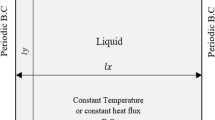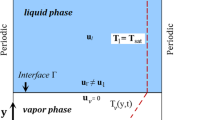Abstract
Automata are entities defined by mathematical states that change following iterative rules representing neighborhood interactions. A model of automata for pool boiling heat transfer simulation consisting in collections of virtual spheres that change their volumes and move around a certain environment is presented. The approach is an alternative technique to describe the turbulent features of boiling phenomena, such as interfacial topological transitions and fluid-wall interaction. The novel computer model presented here is able to capture the essential features underlying boiling heat transfer and crisis above a small heater, showing good agreement with experimental data reported in the open literature.
















Similar content being viewed by others
Abbreviations
- A l :
-
Fraction of area in direct contact with the liquid
- c mc :
-
Microconvection constant
- g :
-
Gravity acceleration
- H :
-
Convection heat transfer coefficient
- h fg :
-
Latent heat of evaporation
- Ja :
-
Jakob number
- k l :
-
Liquid conduction heat coefficient
- k m :
-
Metal conduction heat coefficient
- L :
-
Characteristic cell length
- L c :
-
Channel length
- Nu :
-
Nusselt number
- p :
-
Breakup probability per time unit
- P :
-
Cell perimeter
- p b :
-
Breakup coefficient (0 < p b < 1)
- Pr :
-
Prandtl number
- \( \dot{q} \) :
-
Volumetric heat source
- q c :
-
Convection associated heat
- q mc :
-
Microconvection associated heat
- q ml :
-
Microlayer theory associated heat
- r :
-
Bubble radius
- r 0 :
-
Previous bubble radius
- Ra :
-
Rayleigh number
- r c :
-
Critical bubble radius
- R cav :
-
Cavity radius
- r d :
-
Detachment bubble radius
- t :
-
Time
- T :
-
Cellular automata temperature
- T sat :
-
Saturation temperature
- T w :
-
Wall temperature
- α l :
-
Liquid thermal diffusivity
- β :
-
Volumetric thermal expansion coefficient
- Δ:
-
Cell side
- Δt :
-
Time that went since the last bubble detachment
- ε :
-
Heater emissivity
- ϕ :
-
Contact angle
- ν :
-
Liquid kinematic viscosity
- σ :
-
Surface tension coefficient
- σ rad :
-
Stefan–Boltzmann constant
- ρ l :
-
Liquid density
- ρ v :
-
Vapor density
- τ :
-
Time lag associated to each change
References
Wallis G (1969) One-dimensional two-phase flow, chap 2. McGraw-Hill, New York
Zuber N, Findlay J (1965) Average volumetric concentration in two-phase systems. J Heat Transf 87:453–468
Cooper N (ed) (1987) Los Alamos science special issue. Los Alamos National Laboratory, New Mexico
Ulam S (1958) John von Neumann, 1903–1957. Bull Am Math Soc 64:1–49
Wolfram S (1986) Cellular automata fluids. J Stat Phys 45:3–4
Herault A, Vicari A, Ciraudo A, Del Negro C (2008) Forecasting lava flow hazards during the 2006 Etna eruption: using the MAGFLOW cellular automata model. Comput Geosci (in press)
Fan Y, Ying S, Wang B, Wei Y (2008) The effect of investor psychology on the complexity of stock market: an analysis based on cellular automaton model computers and industrial engineering (in press)
Slimi R, El Yacoubi S, Dumonteil E, Gourbière S (2008) A cellular automata model for Chagas disease. Appl Math Model (in press)
Shoham Y (1993) Agent-oriented programming. Artif Intell 60:51–92
Meyer B (1997) Object-oriented software construction, 2nd edn. Prentice-Hall, Englewood Cliffs
Herrero V, Guido-Lavalle G, Clausse A (1996) Geometrical automata for two phase flow simulation. Nucl Eng Des 163:117–124
Jing Y, Guo L, Zhang X (2003) A numerical simulation of pool boiling using CAS model. Int J Heat Mass Transf 46:4789–4797
Chen T, Chung JN (2002) Coalescence of bubbles in nucleate boiling on microheaters. Int J Heat Mass Transf 45:2329–2341
Booch G (1991) Object oriented with applications. Benjamin/Cummings Publishing Company, Inc., Redwood City
Leidenfrost JG (1966) De aquae communis nonnullis qualitatibus tractatus (A tract about some qualities of common water), Duisburg, 1756; The pertinent portions are reprinted in translation in Int J Heat Mass Transf 9:1153
Nukiyama S (1966) The maximum and minimum values of heat transmitted from metal to boiling water under atmospheric pressure. Int J Heat Mass Transf 9:1419
Forster HK, Zuber N (1955) Dynamics of vapor bubbles and boiling heat transfer. AIChE J 1(4):531–535
Forster KE, Greif R (1959) Heat transfer to a boiling liquid mechanism and correlations. J Heat Transf 81:43–53
Han CY, Griffith P (1965) The mechanism of heat transfer in nucleate pool boiling. Int J Heat Mass Transf 8:887–914
Mikic BB, Rohsenow WM (1969) A new correlation of pool boiling data including the effect of heating surface characteristics. J Heat Transf Trans ASME 91:245–250
Snyder NW (1956) Summary of conference on bubble dynamics and boiling heat transfer, JPL memo 20-137, Jet Propulsion laboratory, California Institute of Technology
Kutateladze SS, Leont’ev AI (1966) Some applications of the asymptotic theory of the turbulent boundary layer. In: Proceedings of the 3rd international heat transfer conference, New York
Thorgeson EJ, Knoebel DH, Gibbons JH (1974) A model to predict convective subcooled critical heat flux. J Heat Transf 96:79–82
Katto Y, Yokoya S (1968) Principal mechanism of boiling crisis in pool boiling. Int J Heat Mass Transf 11:993–1002
Matorin AS (1973) Correlation of experimental data on heat transfer crisis in pool boiling of pure liquids and binary mixtures. Heat Transfer Sov Res 5:85
Costello CP, Book CO, Nichols CN (1963) A study of induced convective effects on saturated pool boiling burnout. Chem Eng Prog Symp Ser 61:271
Tong LS (1972) Boiling crisis and critical heat flux. AEC Critical Review Series, USAEC
Whalley PB, Hutchinson P, Hewitt GF (1974) Calculation of critical heat flux in forced convection boiling. In: 5th International heat transfer conference, Tokyo
Lahey R Jr (ed) (1992) Boiling phenomena. Elsevier, Amsterdam, pp 86–91
Carrica P, Clausse A (1994) A mathematical model of local boiling nonlinear dynamics and crisis. Lat Am J Appl Res 24:77–83
Van Stralen S, Cole R (1979) Boiling phenomena, vol 1. McGraw-Hill, NY, 130 pp
Cooper M (1970) The microlayer and bubble growth in nucleate pool boiling. Int J Heat Mass Transf 13:656–666
Cooper M, Lloyd J (1970) Transient local heat flux in nucleate boiling. In: Proceedings of the 3rd international heat transfer conference, Chicago, vol 3, B2.1. Elsevier, Amsterdam
Cooper M, Lloyd J (1969) The microlayer in nucleate pool boiling. Int J Heat Mass Transf 12:895–913
Cooper M, Vijuk R (1970) Bubble growth in nucleate pool boiling. In: Proceedings of the 4th international heat transfer conference, Paris, Versailles, vol 5, B2.1. Elsevier, Amsterdam
Fritz W (1935) Berechnung des Maximalvolumens von Dampfblasen. Physics 36:379–384
McAdams W (1954) Heat transmission, chap 4, 3rd edn. McGraw-Hill, New York
Goldstein R, Sparrow E, Jones D (1973) Natural convection mass transfer adjacent to horizontal plates. Int J Heat Mass Transf 16:1025–1030
Lloyd J, Moran W (1974) Natural convection mass transfer adjacent to horizontal surfaces of various platforms. ASME, 4-WA/HT-66
Van Stralen S, Cole R (1979) Boiling phenomena, vol 2. McGraw-Hill, New York, pp 456–458
Lahey R Jr (ed) (1992) Boiling phenomena. Elsevier, Amsterdam, pp 402–404
Incropera F, Dewitt D (2006) Fundamentals of heat and mass transfer, 5th edn. Wiley, New York
Stephan P, Fuchs T (2009) Local heat flow and temperature fluctuations in wall and fluid in nucleate boiling systems. Heat Mass Transf 45:919–928
Golobic I, Petkovsek J, Baselj M, Papez A, Kenning DBR (2009) Experimental determination of transient wall temperature distributions close to growing vapor bubbles. Heat Mass Transf 45:857–866
Chen T, Chung JN (2002) Coalescence of bubbles in nucleate boiling on microheaters. Int J Heat Mass Transf 45:2329–2341
Marcel CP, Rohde M, Van der Hagen THJJ (2008) Fluid-to-fluid modeling of natural circulation boiling loops for stability analysis. Int J Heat Mass Transf 51:566–575
Serizawa A, Kataoka I, Michiyoshi I (1975) Turbulence structure of air–water bubbly flow—II. Local properties. Int J Multiph Flow 2:235–246
Žun I (1980) The transverse migration of bubbles influenced by walls in vertical bubbly flow. Int J Multiph Flow 6:583–588
Wang SK, Lee SJ, Jones OC Jr, Lathey RT Jr (1987) 3-D turbulence structure and phase distribution measurements in bubbly two phase flows. Int J Multiph Flow 13:327–343
Buchholz M, Lüttich T, Auracher H, Marquardt W (2004) Experimental investigation of local processes in pool boiling along the entire boiling curve. Int J Heat Fluid Flow 25:243–261
Van Stralen S, Cole R (1979) Boiling phenomena, vol 2. McGraw-Hill, New York, 632 pp
Gupta A, Ghoshdastidar P (2006) A three-dimensional numerical modeling of atmospheric pool boiling by the coupled map lattice method. ASME J Heat Transf 128:1149–1158
Author information
Authors and Affiliations
Corresponding author
Rights and permissions
About this article
Cite this article
Marcel, C., Bonetto, F. & Clausse, A. Simulation of boiling heat transfer in small heaters by a coupled cellular and geometrical automata. Heat Mass Transfer 47, 13–25 (2011). https://doi.org/10.1007/s00231-010-0667-6
Received:
Accepted:
Published:
Issue Date:
DOI: https://doi.org/10.1007/s00231-010-0667-6




